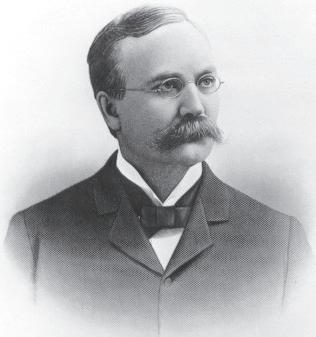
6 minute read
Fuel & Iron
continued from page 1
Realty bought the building in May 2021. Construction on the food hall began in July 2021, and has met several delays as it was originally meant to be completed by last summer.
Advertisement
What we’ve found out with construction is that it never goes according to plan,” Stern said.
Because the Holmes building was only used as a retail store or a warehouse, the interior of the building was a blank slate for Fuel & Iron. If not for that, historic preservation societies would have likely made the company keep the original configuration of the rooms which would have been difficult to achieve what they wanted with this building.
According to Stern, the first level was perfect for what the company needed for the Food Hall as there was an easy back-of-house that they could use for storage or deliveries.
The Food Hall holds the liquor license and acts as the bar for the establishment. Fuel & Iron covers the front-of-house team and dishwashing team, which helps to mitigate costs for new restaurant entrepreneurs. The Food Hall operates with a base rent and a percentage fee.
There are five restaurants set up for the opening:
• Diavolo Hot Chicken, by the owners of Bingo Burger, is a take on the fried chicken sandwich with Pueblo chiles.
• Santa Fonda, by José Avila, who owns Denver’s La Diabla, described as an “authentic pozole y mezcal” experience, which will blend authentic Mexican food with Pueblo ingredients.
• Mosh Ramen offers pan-Asian-inspired street food.
• The Hungry Buffalo, which is a food truck primarily that specializes in bison-themed menu items, will be included in the lineup of restaurants in the Food Hall. Chefs Charles McKay and Sue Ray started operations in 2021.
• Steel Crescent Kitchen is bringing a Cajun-meets-Pueblo fusion spin.
The five-business system means that these restaurants will eventually have to rotate. Stern said one exception is the Solar Roast Coffee and Ice Cream establishment, which is not on a staggered lease.
To be selected for a spot in the Food Hall, the idea for the restaurant must be unique and the applicant must intend to expand into brick-and-mortar.
To allow for another stream of revenue and opportunity for education, Fuel & Iron is opening Fuel Kitchens, a commissary kitchen that allows chefs to prep packaged food products. It is located on the East Side of Pueblo. There will be 16 member spaces available. Membership comes with a fee that covers a certain amount of storage space and kitchen time. There will be additional space, food truck storage, etc,. available for members as well.
Avila and Fuel & Iron through Fuel Kitchens are hoping to start a tortilla production line from Rocky Mountain Farmers Union, which could be sold in grocery stores at some point.
“Hopefully, we’ll be connected with a farmer in Pueblo to work on producing a specific variety of heirloom corn,” Stern said. “José then could grow the corn locally in Pueblo, produce the tortillas here at commissary kitchen and then serve the tortillas at the Food

Hall in addition to his other restaurants.”
Chefs Charles McKay and Sue Ray of The Hungry Buffalo want to use the commissary kitchen to produce buffalo jerky.
In addition to allowing food prep and packaging, there is a fenced space to allow several food trucks to park. Stern said this will be beneficial in the off-season because chefs can pivot to packaged goods.
Fuel Farm, located beside the Food Hall, will act as a space to promote agricultural learning paths.
“It’s not really going to be a revenue-generating enterprise,” Stern said. “We’re organizing it as a nonprofit... And so, for that, you won’t actually be able to launch a business at the urban farm. But you’ll hopefully gain the skills that you need to purchase or lease a small plot of land and launch your own farm.”
The Fuel Farm will be USDA organic. According to Montgomery, Fuel Farm will act as an urban farm within the quarter-acre space but “it will have the production of an 8-acre farm.” Fuel Farm will have wheelchair-accessible beds, a 70-foot by 30-foot greenhouse and an aquaponic system.
Industry breakdown
But what does the food industry look like in Pueblo?
According to the Bureau of Labor Statistics in 2021, the annual wage for restaurant cooks in Pueblo County was above the national average by $890. And while chefs and head cooks made $1,880 under the national average, institutional and cafeteria cooks made only $400 below their national average. For any worker in the food industry field from dishwasher to chef, Pueblo’s average annual income, at $31,530, is over $2,000 above the national average.
According to the Colorado Restaurant Association, in 2023, Colorado restaurants employ 8% of the state’s workforce, making up 10% prior to the pandemic. From entry level to owner, four in five restaurant owners said they started in an entry-level position. Nearly 70% of restaurants in Colorado are independently owned.
Though, according to the Colorado Restaurant Association, operational costs are at a four-decade record high and eight out of 10 restaurants are struggling to hire staff.
According to the Colorado Restaurant Association’s survey of 174 operators in 2022, in an effort to keep and gain talent, “more than 92% of restaurants have changed business practices or wage rates to increase hiring and retention, with one in four restaurants offering retention and hiring bonuses.”

All this in mind, Pueblo did lose a prominent program in the field.
Culinary program
Pueblo Community College, for 35 years, was the most prominent culinary arts program in Pueblo. In 2005, The American Culinary Federation awarded the program its “seven-year accreditation,” which was typically reserved for four-year culinary institutions.
From 2017-22, the program saw enrollment drop by half, according to The Pueblo Chieftain, which covered the program’s closure in June 2022. In January, The Chieftain covered further complications PCC has been facing with producing employable graduates, explaining that the culinary program was given one year to reinvent the program to raise enrollment but could not. The program closed.
Mo Montgomery, the culinary director for the Fuel & Iron project and former director of hospitality and culinary arts at PCC, is spearheading the apprenticeship program.
“We are going to have a really robust apprenticeship program,” she said. “All three of our apprenticeships have a goal of bringing the apprentice to entrepreneurship in a pathway. Overall, we’re looking at career pathways from high school on. But we will accept folk of any age in the apprenticeship program. We’re trying to make it as accessible as possible, and we’re particularly focusing on rural high schools.”
Montgomery has been speaking to schools across the districts, through a partnership with the nonprofit organization Generation Schools Network, to figure out how to deliver this programming to high schools.
The first apprenticeship is set to begin this summer with a focus on the culinary arts. The next apprenticeship to be offered will open in 2023 through the Fuel Farm. It is a “one-of-a-kind agriculture” program, according to Montgomery. The third will have a focus on consumer packaging and food manufacturing.
“Eventually, when they’re ready, they’ll be able to launch a restaurant on the Food Hall, launch a packaged product business at the commissary kitchen, or go and eventually open their own farm,” Stern said.
Montgomery wants to lead the apprenticeship programs “with a foundation on cultural appreciation of the unique foodways of Pueblo.”
“I think that the foodways here are really undervalued, both by locals and abroad,” Montgomery said. “So, by building that understanding and the historical and cultural context of our different food items, our traditions, the things we hand down through our families, appreciating that for the gem that it is.”
The culinary apprenticeship will be a three-year program accredited through the ACF. According to Montgomery, apprenticeship has two components: related instruction and on-the-job learning, designated by the Department of Labor. Fuel & Iron acts as the sponsor. The sponsor means, according to Montgomery, that “we’re in charge of finding instructors and employing them, maintaining the curriculum and doing all the reporting to the Department of Labor.”
“So we’re essentially taking the role of the educational institution, but what’s cool is with apprenticeship is we can also be the employer,” Montgomery said.
According to Montgomery, culinary arts apprentices will do a rotation at the restaurants in the Food Hall or work special events if those restaurants can- not provide that experience. With the option of providing special events, the restaurants do not need to adjust their practices or menu to accommodate student experience and long-distance apprentices can meet the instructional requirement online and attend special events. Montgomery said local apprentices can gain college credit through the Emily Griffith Technical College. Apprentices will receive five certifications relevant to their industry with the highest certification earned being “certified sous chef” from the ACF.
Apprenticeship programs, according to Montgomery, are required to provide minimum wage with incremental raises. While it is calculated based on the living wage, Fuel & Iron estimates the wages to start at $16 an hour with 50-cent raise, which would lead to a $17.50 hourly wage by the third year.

While the first year requires apprentices to work at the Food Hall, years two and three can be out in the industry.
Affordable housing
In finding the property that would fit their initial vision of the Food Hall, according to Stern, they never envisioned getting a multistory building. The Holmes Hardware Building won them over, and with the two extra floors that were not needed for the Food Hall to operate, they could do something more than they had first thought. Stern said they “kind of became accidental housing developers” because of that.
In order to make our numbers work, we had to figure out a way to generate revenue from the second and third floors. The company looked towards the housing shortage as a solution.










